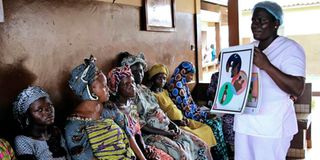Women to lead in fight against HIV in South Nyanza

Blandine Mekpo, a midwife at a maternity ward, provides information about HIV/Aids to pregnant women in Bohicon in southern Benin.
What you need to know:
- Ministry of Health will actively involve women in the fight against HIV/Aids in South Nyanza.
- According to 2020 National Aids Control Council data, more than 1,184 children newly infected with HIV were from the four counties of Nyamira, Migori, Kisii and Homa Bay.
The Ministry of Health will actively involve women in the fight against HIV/Aids in South Nyanza, a region leading in infections of the virus. This is to help curb transmissions from mother to child.
According to 2020 National Aids Control Council (NACC) data, more than 1,184 children newly infected with HIV were from the four counties of Nyamira, Migori, Kisii and Homa Bay.
On Tuesday, women leaders from the region gathered at Itibo Resort in Kisii County under the Women Leadership Forum, majorly involving Maendeleo ya Wanawake, to discuss how to prevent HIV transmission from mother to child.
Health Principal Secretary Susan Mochache and Kisii Governor James Ongwae graced the meeting whose theme was “Women at the Centre of the Journey towards Self -Reliance in the HIV Response.”
Ms Mochache said that though HIV remains an engendered issue for women and girls in the country, Kenya has made significant progress, but not enough to stop the infections, especially among children, girls and women.
By the end of 2020, close to 900,000 women were living with HIV. Of this, 95,000 are young girls and women aged 15-24.
Public health and social issue
More than 150,000 of these women are from the counties of Migori, Homa Bay, Nyamira and Kisii counties.
Ms Mochache noted that HIV remains both a public health and social issue that requires political solutions.
“Let me thank the county leadership represented here today, for embarking on the process of developing county led plans that will allow us to break the cycle of new HIV infections and ensure all those infected are on medication,” said the Health PS.
She noted that Kenya is witnessing dwindling donor resources in the fight against HIV/Aids after the reclassification as a middle-income country.
“The Ministry of Health has embarked on a dialogue towards self-reliance to ensure that as a country, we can allocate sufficient domestic resources to provide commodities for life-long treatment,” she said.
At the centre of the journey towards self-reliance, is the cushioning of the many women and girls living with HIV against being disproportionately affected by over-reliance of donor funding that remains unpredictable in line with the universal health coverage.
Kenya requires Sh45 billion annually to procure Anti-Retroviral (ARVs) drugs and other commodities. Sh20 billion and Sh2.4 billion is required to buy the lifesaving drugs for women and children respectively.
Gender-based violence
The burden of HIV among these women and girls goes beyond their medication to include stigma and discrimination, cultural dis-inheritance and gender-based violence.
While this challenge has been driven by biomedical, structural and behavioural issues over the years, there is no other sub-population that has been impacted by the emergence of Covid-19 pandemic like young girls.
“We have witnessed marked increase in reports of teenage pregnancies and gender-based violence during this difficult period. Each teenage pregnancy serves as a proxy for potential HIV and STI infection through unprotected sex, which threatens to erode gains made in the response,” said the Health PS.
According to reports, progress towards reduction of HIV incidence from 2018 to 2020 ranks Kisii among 15 counties that have put a reverse gear to the gains with increased HIV infections.
Kisii County has a HIV prevalence of 4.9 per cent with an estimated 41,408 people living with HIV - 39,292 adults and 2,359 children.
The devolved unit had 1,566 new infections with 469 deaths in 2020.
“We have identified and put 33,060 people on antiretroviral treatment, 31,169 adults and 1,891 children,” said Mr Ongwae.
The county chief noted that amid the prevailing incidence of the Covid-19 pandemic, members of the public had shied from attending medical clinics and those on HIV related therapy fall in this category.





